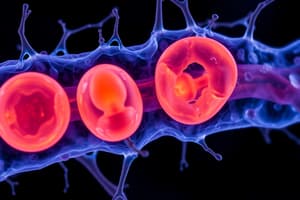Podcast
Questions and Answers
Which organelle is responsible for capturing light energy to make sugars in plants and photosynthetic bacteria?
Which organelle is responsible for capturing light energy to make sugars in plants and photosynthetic bacteria?
- Endoplasmic reticulum
- Nucleus
- Chloroplasts (correct)
- Mitochondria
The thylakoid lumen in chloroplasts is equivalent to the mitochondrial matrix.
The thylakoid lumen in chloroplasts is equivalent to the mitochondrial matrix.
False (B)
During carbon fixation, which key molecule is produced using the electron carrier and ATP coming from light reactions? _.
During carbon fixation, which key molecule is produced using the electron carrier and ATP coming from light reactions? _.
Glycerolaldehyde 3-phosphate
Which of the following descriptions applies to dark reactions rather than light reactions in plant chloroplasts?
Which of the following descriptions applies to dark reactions rather than light reactions in plant chloroplasts?
When daylight hours are less and temperatures are cooler, what happens to the production of chlorophyll in leaves?
When daylight hours are less and temperatures are cooler, what happens to the production of chlorophyll in leaves?
Only chloroplasts can be seen using conventional light microscopy.
Only chloroplasts can be seen using conventional light microscopy.
Dynamin is a mechanoenzyme involved in:
Dynamin is a mechanoenzyme involved in:
Which of the following is NOT true about mitochondria?
Which of the following is NOT true about mitochondria?
Which of the following is false about the mitochondrial ATP-synthase?
Which of the following is false about the mitochondrial ATP-synthase?
Flashcards are hidden until you start studying
Study Notes
Mitochondria Structure and Function
- Mitochondria are heterogeneous and dynamic organelles that change shape, divide, and fuse, and are associated with the cell cytoskeleton.
- Mitochondria specialize into distinct tissue-specific phenotypes, which are highly variable in structure and function.
- Mitochondria are surrounded by a double-membrane system, with an inner and outer membrane separated by an intermembrane space.
- The inner membrane forms numerous folds (cristae) that extend into the interior (matrix) of the organelle.
- The matrix is highly concentrated in proteins, contains the genetic system of the mitochondria, and is the site of food-derived molecule conversion into energy (ATP).
Mitochondrial Function
- Mitochondria perform several interconnected functions, including ATP production, biogenesis of heme groups and iron-sulfur clusters, synthesis of phospholipids, and regulation of apoptosis.
- ATP production involves the conversion of food-derived substrates into acetyl CoA, which is then oxidized in the matrix via the Krebs cycle, producing electrons that are transferred to the electron-transport chain.
- The electron-transport chain generates an electrochemical gradient that drives the synthesis of ATP by the ATP synthase.
- ATP synthase is a nanomachine that can work in forward (to produce ATP) or in reverse (to hydrolyze ATP) and is arranged as dimers in the tip of the cristae.
Chloroplasts Structure and Function
- Chloroplasts are large organelles present in plants and photosynthetic bacteria, responsible for capturing light energy to make sugars in a process called photosynthesis.
- Chloroplasts have an outer and inner membrane, with internal thylakoid compartments and a stroma that contains metabolic enzymes, the ATP synthesis machinery, and the chloroplast's genetic system.
- Thylakoid membranes are highly folded into numerous local stacks of flattened vesicles called granum or grana, interconnected by non-stacked thylakoids (stroma lamellae).
Photosynthesis
- Photosynthesis is a process by which plants use CO2 and H2O to make carbohydrates, divided into two categories: light reactions and carbon-fixation reactions.
- Light reactions involve the conversion of light energy into chemical energy, generating NADPH and ATP, which are then used in the carbon-fixation reactions.
- Carbon-fixation reactions involve the conversion of CO2 into glycerolaldehyde 3-phosphate, a critical intermediary sugar for the synthesis of sugars, amino acids, and fatty acids.
Light Reactions
- Light reactions occur in the thylakoid membranes of chloroplasts and involve the transfer of electrons and protons, generating an electrochemical gradient that drives ATP synthesis.
- The process involves the absorption of light energy by chlorophyll, which is used to generate a positively charged chlorophyll ion, and the transfer of electrons to a second reaction center, resulting in the storage of electrons and H+ in NADPH.
Dark Reactions
-
Dark reactions involve the carbon-fixation cycle, which uses NADPH and ATP produced in the light reactions to convert CO2 into glycerolaldehyde 3-phosphate.
-
The carbon-fixation cycle is a series of reactions that occur in the stroma of the chloroplast, using the energy from ATP and NADPH to drive the conversion of CO2 into organic compounds.### Carbon Fixation
-
Carbon fixation produces glycerolaldehyde 3-phosphate using the electron carrier and ATP from light reactions.
Light Reactions vs. Dark Reactions
- Dark reactions produce the sugar glyceraldehyde 3-phosphate.
- Light reactions involve the electron-transfer chain embedded in the thylakoid membrane and produce O2.
- Light reactions generate ATP.
Chloroplasts and Mitochondria
- Chloroplasts convert light energy into chemical energy.
- Mitochondria consume the chemical energy to produce ATP.
- Optimal carbon fixation and plant growth require coordinated actions between chloroplasts and mitochondria.
Chloroplasts and Viral Replication
- Many plant viral pathogens change and/or rearrange chloroplasts for viral replication.
- Viral influence on chloroplast structures and functions usually leads to depleted photosynthetic activity.
Leaf Color Change in Fall
- As daylight hours decrease and temperatures cool, photosynthesis slows down, and chlorophyll production decreases.
- This reveals yellow or orange pigments called carotenoids.
- Anthocyanins are produced mainly in the fall and are dissolved in the cell sap.
- Cool fall temperatures cause the closing of leaf veins, preventing sugars from moving out, which prolongs fall color.
Studying That Suits You
Use AI to generate personalized quizzes and flashcards to suit your learning preferences.



